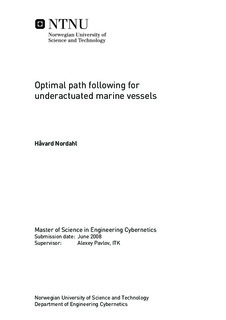Optimal path following for underactuated marine vessels
Master thesis
Permanent lenke
http://hdl.handle.net/11250/259692Utgivelsesdato
2008Metadata
Vis full innførselSamlinger
Sammendrag
This report presents two optimization problems, where three cost-functions are suggested for each. The goal for the first optimization problem is to find a time variant look-ahead distance which improves the performance of the vessel in terms of the cross-track error, relative to constant look-ahead distances. The second optimization problem is an extension of the first, where a time variant surge velocity reference is also calculated. This results in smaller cross-track errors, at the cost of increased calculation time. It is assumed that the path and the desired surge velocity on the path is supplied by some external source. Existing kappa-exponential control laws are used to track the references resulting from the calculated optimal look-ahead distance and surge velocity reference. The predictions needed to solve the optimization problem are made from a model where the control laws are inserted into the dynamics to simplify the model. The optimization problems are solved for two different approaches. The first approach uses an LTV model for predictions and a QP-solver to solve the optimization problem. The second approach forms predictions of the states by numerical integration of the system dynamics and uses an optimization problem solver for general non-linear functions to solve the optimization problem. The latter approach generally results in longer calculation times but better accuracy, while the first approach yields convexity of the optimization problem. A passive observer is used to estimate the current such that it can be included in the predictions. Four of the six suggested cost-functions lead to significantly improved performance of the vessel in terms of the cross-track error. This is true both in the case of no disturbances and in the presence of a constant irrotational current. That is, the position of the vessel converges faster to the path, the vessel stays closer to the path and has less over-shoot in the cross-track error, for the optimal inputs than for constant inputs. The cost-functions includes weights for tuning where the tuning process is easy for some of the cost-functions. One of the cost-functions where only the optimal look-ahead distance is calculated, results in calculation times shorter than the time between samples, after a few time steps. This is a promising result since the application of MPC to fast-dynamic systems such as marine vessels is desired, but often problematic due to too long calculation times for solving the optimization problem. It takes more time to solve the optimization problem when the optimal surge velocity reference is found in addition to the optimal look-ahead distance.
